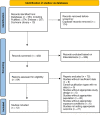Relationship between the triglyceride-glucose index and risk of cardiovascular diseases and mortality in the general population: a systematic review and meta-analysis
- PMID: 35778731
- PMCID: PMC9250255
- DOI: 10.1186/s12933-022-01546-0
Relationship between the triglyceride-glucose index and risk of cardiovascular diseases and mortality in the general population: a systematic review and meta-analysis
Abstract
Background: The triglyceride-glucose (TyG) index is a new alternative measure for insulin resistance. This meta-analysis was conducted to assess the associations of the TyG index with the risks of cardiovascular diseases and mortality in the general population.
Methods: The PubMed, Cochrane Library and Embase databases were searched for randomized controlled trials or observational cohort studies reporting associations of the TyG index with cardiovascular diseases and mortality from inception to April 16, 2022. Effect sizes were pooled using random-effects models. Robust error meta-regression methods were applied to fit nonlinear dose-response associations. Evidence quality levels and recommendations were assessed using the Grading of Recommendations Assessment, Development and Evaluation system (GRADE).
Results: Twelve cohort studies (6 prospective and 6 retrospective cohorts) involving 6,354,990 participants were included in this meta-analysis. Compared with the lowest TyG index category, the highest TyG index was related to a higher incidence of coronary artery disease (CAD) (3 studies; hazard ratio [HR] = 2.01; 95% confidence interval [CI] 1.68-2.40; I2 = 0%), myocardial infarction (MI) (2 studies; HR = 1.36; 95% CI 1.18-1.56; I2 = 35%), and composite cardiovascular disease (CVD) (5 studies; HR = 1.46; 95% CI 1.23-1.74; I2 = 82%). However, there was no association between the TyG index and mortality (cardiovascular mortality [3 studies; HR = 1.10; 95% CI 0.82-1.47; I2 = 76%] or all-cause mortality [4 studies; HR = 1.08; 95% CI 0.92-1.27; I2 = 87%]). In the dose-response analysis, there was a linear association of the TyG index with the risk of CAD (Pnonlinear = 0.3807) or CVD (Pnonlinear = 0.0612). GRADE assessment indicated very low certainty for CVD, MI, cardiovascular mortality and all-cause mortality, and moderate certainty for CAD.
Conclusions: Based on our current evidence, a higher TyG index may be associated with an increased incidence of CAD (moderate certainty), MI (very low certainty) and CVD (very low certainty) in the general population. There is a potential linear association of the TyG index with CAD and the composite CVD incidence. Further prospective studies (especially in non-Asians) are needed to confirm our findings.
Keywords: Cardiovascular disease; Coronary artery disease; Meta-analysis; Mortality; Triglyceride-glucose index.
© 2022. The Author(s).
Conflict of interest statement
The authors declare no competing financial interests.
Figures





References
Publication types
MeSH terms
Substances
LinkOut - more resources
Full Text Sources
Medical
Miscellaneous

